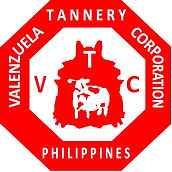
Valenzuela Tannery Corporation
Welcome to Craftsmanship!
Our Process
We invite and encourage our customers to visit the tannery to witness and experience leather processing firsthand. We want our customers to understand the care we take in producing world-class leathers.
We invest in modern equipment to make sure that we can deliver consistent quality. Our team includes qualified chemists who uses the latest tanning chemistry technology where they make sure the process is well controlled.
Throughout the process, we incorporate series of quality checks so we can provide the high quality, world-class leather you need.

Preparatory Stage
These processes remove unwanted material from the hides. In soaking, water is used for the purpose of washing and rehydration. In addition, the hide is returned to its natural moisture content and protected from bacteria.
Liming removes the hair, epidermis, and other unwanted proteins. As a result, the pelts swell in preparation for subsequent processes. After 22 hours of processing, the hide becomes the “limed pelt”.
CURING
We use both imported and local cow and carabao (water buffalo) hides. Curing is a preparatory step where preservation of the leather is done. Pickling and depickling is done where the pH levels of the hides are lowered or raised using salts to assist in the penetration of tanning agents in order to protect them from microbial attack.
SOAKING & LIMING
These processes remove unwanted material from the hides. In soaking, water is used for the purpose of washing and rehydration. In addition, the hide is returned to its natural moisture content and protected from bacteria.
Liming removes the hair, epidermis, and other unwanted proteins. As a result, the pelts swell in preparation for subsequent processes. After 22 hours of processing, the hide becomes the “limed pelt”.
FLESHING
During this process, any additional unwanted tissue is mechanically removed from the flesh side such as the natural fats/oils, and other fat layers.
BATING
This process introduces Proteolytic proteins to the flesh to achieve more protein removal and assist in softening the pelt.

Tanning Stage
Tanning converts the protein of the raw hide into a stable material suitable for use in different end applications. Tanning is essential in the overall process as it prevents the hides from drying out and decaying.
CHROME TANNING
The delimed, bated, & pickled pelts are treated with chrome tanning salts (chrome sulphates) converting these into the stable material we know as leather. This process, which can take up to 24 hours, results in a product commonly called “wet blue” and is ready to be stored for later processing.
The product is called “Wet Blue” due to the tanning material chronium, which leaves the leather a pale blue color after the tanning process.
VEGETABLE TANNING
Vegetable tanned leather is an alternative method of tanning the cowhide into leather. This process uses natural materials used in the tanning process like tree bark, instead of using chemicals.
Vegetable tanning is a sustainable and eco-friendly way of tanning the leather. It is one of the oldest methods in the leather tanning industry.
Valenzuela Tannery Corporation is proud that we continuously look for progressive and sustainable ways. Chrome tanned leather by-products are well-treated, thus water disposal are actually clean and good for agricultural use.

Crusting Stage
SAMMYING
Excess moisture is squeezed out of the leather by passing through large felt covered rollers.
CHROME SPLITTING
The leather is split into two or more horizontal layers. The structure and thickness of the leather naturally vary from one part of the hide to another.
The leather is split into:
a) grain (upper layer) – uniform thickness
b) flesh split (lower layer) – varying thickness.
SHAVING
The thickness of the leather is adjusted using a machine which cuts leather fibers off. The shaving process is carried out to achieve an even thickness throughout the hide. The thickness of the finished leather is dependent on the intended application.
WET AND BLUE SORTING
The Wet Blue Leather is then sorted into different grades to comply with the customer's specifications.
RE-TANNING
Re-tanning improves the feel and hand of the leather. It also produces a uniform physical property leather with an improved cutting value or yield for the customer.
SAMMYING/SETTING OUT
At this stage, excess water is further reduced, and the hides are stretched flat to remove the creases in order to maximize the area of the leather.
SAMMYING/SETTING OUT
At this stage, excess water is further reduced, and the hides are stretched flat to remove the creases in order to maximize the area of the leather.
